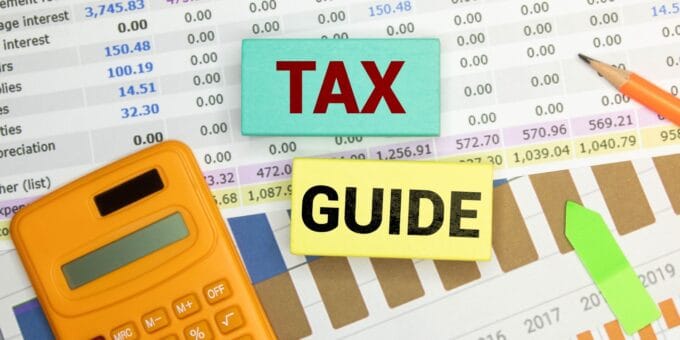As we approach the new tax year, which runs from 6 April 2024 until 5 April 2025, business owners and managers should ensure their knowledge of UK taxation is up to date, including the key changes taking effect in the coming days.
This business tax guide for 2024-25 outlines the various tax rates, allowances, and important measures you need to be aware of, as confirmed in the Spring Budget 2024. The information below will be of help when considering your tax planning over the next 12 months.
Key Takeaways
- National Insurance contributions will significantly decrease for employees and self-employed individuals starting 6 April 2024.
- The Capital Gains Tax allowance drops to £3,000, impacting individuals’ tax liabilities on asset sales.
- The tax-free dividend allowance reduces from £1,000 to £500, increasing potential tax bills for dividend earners.
National Insurance contributions
There are significant changes to the main rates of National Insurance for the 2024-25 tax year, impacting both employed and self-employed individuals across the UK. From 6 April, the following measures will take effect:
- Class 1 National Insurance contributions (NICs) will be reduced to 8%. This rate will apply to employees and company directors earning more than £242/week.
- Class 4 NICs for the self-employed will be reduced to 6%. This rate will apply to self-employed profits of more than £12,570 per year.
- Self-employed individuals with profits above £12,570 will no longer have to pay Class 2 NICs.
If you are an employer, you will continue to pay 13.8% employers’ Class 1 National Insurance on employees’ and directors’ earnings above the Secondary Threshold of £9,100 per year.
However, if eligible, you can reduce your employer’s NIC bill by up to £5,000 by claiming the Employment Allowance.
From 6 April 2025, employers’ NIC will increase to 15%, while the Secondary Threshold will be reduced to £5,000 per year. The Employment Allowance will increase to £10,500 per year.
Income Tax
The standard Personal Allowance for taxpayers in all parts of the UK remains frozen at £12,570 for 2024-25. Sometimes referred to as the ‘tax-free allowance’, this is the amount that most individuals can earn in the year before they have to start paying personal tax.
There are no changes to Income Tax in England, Wales, and Northern Ireland. The rates and thresholds for the 2024-25 tax year are as follows:
| Tax band | Taxable income | Tax rate |
| Personal Allowance | Up to £12,570 | 0% |
| Basic rate | £12,571 to £50,270 | 20% |
| Higher rate | £50,271 to £125,140 | 40% |
| Additional rate | Over £125,140 | 45% |
With the exception of the Personal Allowance, residents of Scotland have different tax bands, thresholds, and rates than taxpayers in the rest of the UK.
The Scottish Government has made adjustments to several thresholds, introduced a new ‘advanced rate’ tax band, and increased the top rate by 1%.
The table below shows the Scottish Income Tax rates payable in each band from 6 April 2024:
| Scottish tax band | Taxable income | Scottish tax rate |
| Personal Allowance | Up to £12,570 | 0% |
| Starter rate | £12,571 to £14,876 | 19% |
| Basic rate | £14,877 to £26,561 | 20% |
| Intermediate rate | £26,562 to £43,662 | 21% |
| Higher rate | £43,663 to £75,000 | 42% |
| Advanced rate | £75,001 to £125,140 | 45% |
| Top rate | Over £125,140 | 48% |
Corporation Tax
UK Corporation Tax rates and thresholds will be maintained at their current levels for 2024-25.
If your company has profits of more than £250,000, you will pay the main rate of Corporation Tax, which is 25%. If your company has profits of £50,000 or less, you will pay the small profits rate instead, which is 19%.
Companies with profits between £50,000 and £250,000 can claim Marginal Relief. This provides a tapered increase in the rate of Corporation Tax between the small profits rate and the main rate.
You can use HMRC’s online tool to check your company’s eligibility and calculate Marginal Relief for Corporation Tax.
Tax on dividends
From 6 April, the tax-free allowance for dividend income will be reduced from £1,000 to £500. This means that you may see an increase in your Self Assessment tax bill if you earn more than £500 in dividends.
However, dividend tax rates and thresholds remain unchanged. If you receive income from dividends, you will continue to pay the following dividend tax rates in 2024-25:
| Tax band | Taxable dividend income | Tax rate |
| Personal Allowance | Up to £12,570 | 0% |
| Basic rate | £12,571 to £50,270 | 8.75% |
| Higher rate | £50,271 to £125,140 | 33.75% |
| Additional rate | From £125,141 | 38.35% |
You won’t pay any tax on dividend income that falls within your annual Personal Allowance and dividend allowance. This means that you can earn £13,070 in dividends tax-free in 2024-25 if you don’t have any other sources of taxable income.
The amount of tax you pay on dividends above that amount depends on your Income Tax band. To work out your tax band, you need to add your total dividend income for the entire year to your other sources of personal income for the same period. If your combined income is more than £50,270, you may have to pay more than one rate of tax on dividends.
Capital Gains Tax
The Capital Gains Tax (CGT) allowance for 2024-25 is £3,000, reduced from £6,000 in the previous tax year. This is available to individuals and personal representatives. There is a different allowance for trustees.
From 6 April, the higher rate of Capital Gains Tax on residential property gains will be reduced from 28% to 24%. The basic rate on residential property gains remains the same as the previous year.
The rates applying to gains from other chargeable assets remain unchanged until 29 October, then increase for gains made after that date, as outlined in the table below:
| Tax band | Gains from residential property | Gains from other chargeable assets |
| Basic rate | 18% | 10% – on gains between 6 April 2024 and 29 October 2024
18% – on gains from 30 October 2024 onwards |
| Higher or additional rate | 24% | 20% – on gains between 6 April 2024 and 29 October 2024
24% on gains from 30 October 2024 onwards |
If you operate as a sole trader or partnership and qualify for Business Asset Disposal Relief, you will pay 10% CGT on any profit you make on the disposal of business assets in the 2024-2025 tax year.
However, this rate will increase to 14% for disposals made on or after 6 April 2025, and then increase again to 18% for disposals made on or after 6 April 2026.
Companies do not pay CGT. If you trade through a company, you will pay Corporation Tax on any profit you make from the sale or disposal of business assets.
VAT rates and thresholds
On 1 April, the government increased both the VAT registration and deregistration thresholds.
The 12-month VAT-taxable turnover threshold for registration increased from £85,000 to £90,000. This is the point at which a business must register for VAT. If your turnover is below the threshold, you have the option to register voluntarily.
The 12-month VAT-taxable turnover threshold for deregistration increased from £83,000 to £88,000. This is the point at which a VAT-registered business can apply to HMRC to deregister for VAT.
In Northern Ireland, the VAT registration and deregistration thresholds for acquisitions increased from £85,000 to £90,000.
There are no changes to VAT rates for the 2024-25 tax year.
Minimum wage rates
The annual increase to the National Living Wage and National Minimum Wage rates came into effect on 1 April.
If you pay any of your employees the minimum rates, you must ensure they receive at least the new hourly rate applicable to their age:
| Age | Minimum hourly rate |
| 21 and over | £11.44 |
| 18-20 | £8.60 |
| Under 18 | £6.40 |
The rules are slightly different for apprentices. They are entitled to the apprentice rate if they are:
- under the age of 19, or
- 19 or over and in the first year of their apprenticeship
However, you must pay an apprentice the correct minimum wage rate for their age, if they are over the age of 19 and have completed their first year.
Pension contributions and payments
As a business owner or manager, you may have to consider various types of pensions in your tax planning for the year ahead. Below is an overview of key information on private pensions, auto-enrolment, and the State Pension for 2024-25.
Private pensions
From 6 April, the Lifetime Allowance of £1,073,100 for private pension savings will be abolished. The standard annual allowance will remain at £60,000. This is the most that you can pay into your pension(s) in a tax year whilst still receiving tax relief.
Workplace pensions
There are no changes to the automatic enrolment earnings thresholds for the new tax year. They will be maintained at the following levels:
- Earnings trigger – £10,000
- Lower earnings limit of the qualifying earnings band – £6,240
- Upper earnings limit of the qualifying earnings band – £50,270
If you are an employer, you must continue to contribute at least 3% of every eligible employee’s qualifying earnings into their auto-enrolment workplace pension.
The State Pension
From April, the State Pension rates will increase by 8.5% under the triple lock guarantee.
The rise means that anyone who qualifies for the new State Pension at the full rate will now receive £221.20 per week (up from £203.85). Those who are eligible for the basic State Pension will receive £169.50 per week (up from £156.20).
Other notable changes for the new tax year
The freeze on Alcohol Duty rates has been extended to 1 February 2025, and the temporary 5p cut in Fuel Duty will remain until 22 March 2026. Several other measures take effect from April 2024 onward, some of which may apply to your business:
1 April 2024
- A merged Research and Development (R&D) tax relief scheme was introduced for company accounting periods beginning on or after 1 April 2024.
- The intensity threshold for enhanced support for R&D was lowered to 30% for company accounting periods beginning on or after this date.
6 April 2024
- The cash basis will become the default accounting method for calculating taxable profits from self-employment. Individuals can still use the traditional accruals basis, but they will need to elect to do so.
- Statutory Sick Pay (SSP) for eligible employees will increase to £116.75 per week.
7 April 2024
- The rate of Statutory Maternity, Adoption, Paternity, Shared Parental, and Parental Bereavement Pay will increase to £184.03 per week.
1 June 2024
- Multiple Dwellings Relief will be abolished. However, if the exchange of contracts took place on or before 6 March 2024, you can still claim the relief even if completion occurs on or after 1 June.
If you need to send a Self Assessment tax return
The start of the new tax year is the first date that you can file a Self Assessment tax return for the previous year. If you’re self-employed or need to report other types of untaxed income (such as dividends) earned in 2023-24, you can complete your Self Assessment tax return online at any time from 6 April.
If this is the first year that you’ll be sending a return, you’ll need to register for Self Assessment with HMRC. The deadline is 5 October 2024. You’ll then be able to complete your return and pay any tax and National Insurance contributions you owe. You can use HMRC’s online tool to check if you need to send a Self Assessment tax return.
The deadline for filing a return online for the 2023-24 tax year is 31 January 2025, so you have plenty of time. However, it’s always best to deal with tax-related obligations as early as possible, to avoid any issues further down the line.
Thanks for reading
We hope you’ve found this business tax guide for 2024-25 useful. If you need help with any tax-related matters, please get in touch with an accountant or independent tax adviser.
Explore the Rapid Formations Blog for more small business news, insights, and guidance.
Please note that the information provided in this article is for general informational purposes only and does not constitute legal, tax, or professional advice. While our aim is that the content is accurate and up to date, it should not be relied upon as a substitute for tailored advice from qualified professionals. We strongly recommend that you seek independent legal and tax advice specific to your circumstances before acting on any information contained in this article. We accept no responsibility or liability for any loss or damage that may result from your reliance on the information provided in this article. Use of the information contained in this article is entirely at your own risk.






Join The Discussion